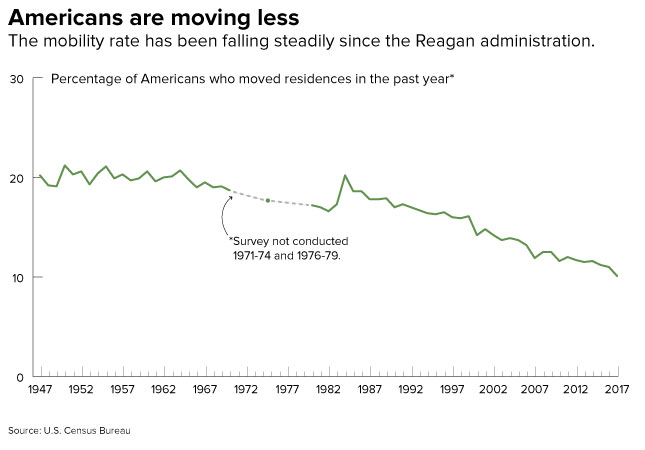Americans stuck in place even as economy booms

The number of Americans who moved residences in the past year has fallen to the lowest levels ever measured by government statisticians, reinforcing the long-term battle for supremacy between urban cores and the rural communities that once dominated American politics.
The lack of mobility has flummoxed demographers and economists, who say they would expect Americans to respond to a booming economy by chasing higher-paying jobs and new opportunities.
The data show the youngest generation of working Americans, those between the ages of 20 and 34, are in fact less mobile than were preceding generations at the same age.
{mosads}
“It’s a head-scratcher to some extent,” said Lawrence Yun, the chief economist at the National Association of Realtors. “The fact that people are not moving is hinting that economic mobilities are still not there.”
About 32.3 million Americans moved residences between 2017 and 2018, according to data from the U.S. Census Bureau. That is the lowest number of movers since 1954, when the country’s population was less than half what it is today.
The percentage of Americans who moved in the past year, 10.1 percent, is the lowest the Census Bureau has recorded since it began keeping track in 1947. That percentage has been dropping steadily since 1984, when 20.2 percent of Americans moved residences. It has fallen even since the Great Recession.
“The decline in mobility is a big mystery yet to be solved. The decline is decades-long and has occurred in every age group, so it’s likely to have multiple causes,” said Cheryl Russell, a demographer who runs the Demo Memo blog.

Russell said declining mobility among younger Americans may be happening because that generation is more likely to delay their entry into the workforce.
The number of high school graduates who go on to college has risen since the turn of the century, and those who live in college dormitories are counted as living with their parents.
About half of 18- to 24-year-olds live with their parents, according to Pew Research Center data, the highest level the Census Bureau recorded in 130 years.
And those who come out of college are more in debt than ever before, which hinders their ability to live independently. The number of renters who have moved between residences has also fallen to record lows, suggesting an inability to buy their own homes.
What’s more, Americans who have taken traditional steps that might have once led to more mobility — like entering the workforce and getting married — are also less likely to move. That may be because more Americans than ever live in dual-income households, and the prospect of moving would mean both partners would have to find new jobs.
“This young group is usually very mobile, and one would think after the end of the recession, the housing market is coming back, the job market is coming back,” which would lead to more mobility, said William Frey, a demographer at the Brookings Institution. “Maybe they really are stuck in place.”
The lack of mobility has cemented other long-term trends driving the American economy, and the electorate, especially the growth of large urban centers and the decline of rural communities.
The 100 largest counties in the country are now home to 137 million Americans, up a combined 9.4 million people between 2010 and 2017, according to the new census data, an increase of about 7 percent. Just two of those counties — the homes of Detroit and Cleveland — lost population over that time.
At the same time, almost two-thirds of the 2,100 counties in the country with fewer than 50,000 residents lost population. Those counties are home to 40 million residents today, 180,000 fewer than lived there in 2010. Rural communities are likely to be older than urban cores, and older populations are less likely to move than younger Americans.
“The growth of cities has been occurring over this long period, with the rural economy falling and city economies rising,” Yun said. “Many people are making that calculation and suddenly realizing they can’t make the move.”
The economic schism between cities, which have grown dramatically since the recovery began, and rural areas that are still struggling to return to pre-recession employment levels has increasingly become a political schism as well.
Rural voters who feel left behind have increasingly backed populist Republicans, culminating in President Trump’s election in 2016, when he pulled a greater share of the vote from small communities than any Republican presidential candidate in recent memory.
At the same time, Democratic presidential nominee Hillary Clinton won a million more votes from the 25 largest counties in America than did former President Obama in 2012.
Democrats now control all but one urban district in the House of Representatives. Republicans hold about four in every five rural House districts, a margin that grew in the 2018 midterm elections.
“This is a decade in which big places have fared best and smaller, more rural places have struggled — and likely will continue to,” said Mark Muro, a senior fellow at the Metropolitan Policy Program at the Brookings Institution.
Copyright 2023 Nexstar Media Inc. All rights reserved. This material may not be published, broadcast, rewritten, or redistributed.

